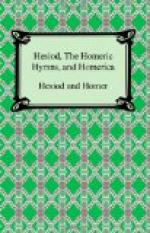(1) The preceding part of the Epic Cycle (?).
(2) While the Greeks were sacrificing at Aulis, a
serpent
appeared and devoured
eight young birds from their nest and
lastly the mother of
the brood. This was interpreted by
Calchas to mean that
the war would swallow up nine full
years. Cp.
“Iliad” ii, 299 ff.
(3) i.e. Stasinus (or Hegesias: cp.
fr. 6): the phrase `Cyprian
histories’ is
equivalent to “The Cypria”.
(4) Cp. Allen “C.R.” xxvii. 190.
(5) These two lines possibly belong to the account
of the feast
given by Agamemnon at
Lemnos.
(6) sc. the Asiatic Thebes at the foot of Mt.
Placius.
THE AETHIOPIS (fragments)
Fragment #1 — Proclus, Chrestomathia, ii: The “Cypria”, described in the preceding book, has its sequel in the “Iliad” of Homer, which is followed in turn by the five books of the “Aethiopis”, the work of Arctinus of Miletus. Their contents are as follows. The Amazon Penthesileia, the daughter of Ares and of Thracian race, comes to aid the Trojans, and after showing great prowess, is killed by Achilles and buried by the Trojans. Achilles then slays Thersites for abusing and reviling him for his supposed love for Penthesileia. As a result a dispute arises amongst the Achaeans over the killing of Thersites, and Achilles sails to Lesbos and after sacrificing to Apollo, Artemis, and Leto, is purified by Odysseus from bloodshed.
Then Memnon, the son of Eos, wearing armour made by Hephaestus, comes to help the Trojans, and Thetis tells her son about Memnon.
A battle takes place in which Antilochus is slain by Memnon and Memnon by Achilles. Eos then obtains of Zeus and bestows upon her son immortality; but Achilles routs the Trojans, and, rushing into the city with them, is killed by Paris and Apollo. A great struggle for the body then follows, Aias taking up the body and carrying it to the ships, while Odysseus drives off the Trojans behind. The Achaeans then bury Antilochus and lay out the body of Achilles, while Thetis, arriving with the Muses and her sisters, bewails her son, whom she afterwards catches away from the pyre and transports to the White Island. After this, the Achaeans pile him a cairn and hold games in his honour. Lastly a dispute arises between Odysseus and Aias over the arms of Achilles.
Fragment #2 —
Scholiast on Homer, Il. xxiv. 804:
Some read: `Thus they performed the burial of
Hector. Then came
the Amazon, the daughter of great-souled Ares the
slayer of men.’
Fragment #3 —
Scholiast on Pindar, Isth. iii. 53:
The author of the “Aethiopis” says that
Aias killed himself about
dawn.




